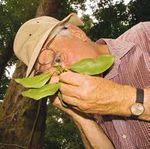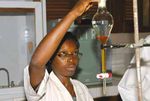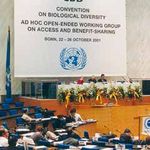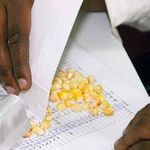From Global to Local: ABS Capacity Development Initiative - A multi-donor initiative spanning nature conservation, poverty alleviation and ...
←
→
Page content transcription
If your browser does not render page correctly, please read the page content below
From Global to Local: ABS Capacity Development Initiative A multi-donor initiative spanning nature conservation, poverty alleviation and governance www.abs-initiative.info
ABS: three letters for development • C reating predictable conditions for accessing genetic resources
and traditional knowledge associated with them;
For centuries, societies across the globe have transferred and traded • Promoting adequate benefit-sharing where genetic resources
biological resources. In doing so, they have drawn from the indig- leave the territory of the provider country and associated tradi-
enous knowledge related to using those resources. Today, industries tional knowledge is being utilised;
such as pharmaceuticals, cosmetics, plant or animal breeding keep • Supporting mechanisms to monitor and ensure stakeholders’
searching globally for genetic resources to develop or enhance their compliance with mutually agreed terms and national ABS regu-
products. Yet, the gains and benefits arising from those transfers latory frameworks.
have hardly ever been shared with the communities of origin. Until
recently, developing countries had no recourse to ensure that the The Nagoya Protocol can be regarded as a key element in designing
use of their genetic resources and traditional knowledge would be a global framework for sustainable development. By valuing biodi-
recompensed. versity in a market economic approach it further represents a build-
The Access and Benefit-sharing (ABS) principle of the CBD ing block for a global green economy.
provides development opportunities in this regard. It aims at ensur-
ing a fair and equitable sharing of the benefits arising from the use
of genetic resources. This means that, where genetic resources are The ABS Initiative: unleashing the potential of ABS
used for scientific or commercial purposes, the country of origin is
to be recompensed. Overall, the purpose of ABS is to: Not everybody at the political-administrative level is yet aware of
the development opportunities that ABS provides. Few countries
• G enerate benefits for poverty alleviation and nature conserva- have functioning national ABS regulatory frameworks in place, and
tion; where they exist, countries tend to have problems with implemen-
• Support capacity development by transferring technologies, tation. Dialogues between stakeholders ought to be strengthened,
knowledge and skills; so as to promote awareness of their mutual and often common
• Enhance social development; interests. Also, regional approaches to ABS should be harmonised,
• Ensure accountability and good governance at all levels. including inventories and information on the value of genetic re-
sources.
The core mechanisms of ABS, and the basis for any agreement be- The adoption of the Nagoya Protocol makes it all the more im-
tween users and providers of genetic resources, are Prior Informed portant to develop the necessary skills to fully harness the potential
Consent (PIC) and Mutually Agreed Terms (MAT). of ABS, and the ABS Capacity Development Initiative addresses
this challenge. It aims at bringing different ABS stakeholders to-
gether for the purpose of negotiating agreements, and for support-
The Nagoya Protocol on ABS ing them in developing the capacities that are necessary to achieve
mutually satisfactory outcomes. These include training in commu-
The Nagoya Protocol, adopted in October 2010 under the aus- nication and negotiation skills, as well as sharing knowledge, infor-
pices of the CBD, is a milestone representing for its Parties an mation and best practice.
internationally agreed and binding framework for access to genetic
resources and the fair and equitable sharing of benefits arising from
their utilisation. It enhances legal certainty and transparency for
users and providers, by:
Resource-rich countries (“Providers”) shall
facilitate access to genetic resources
Prior Informed Consent (PIC)
Users Providers
Mutually Agreed Terms (MAT)
Technology-rich countries (“Users”) shall share benefits arising from
genetic resources; facilitate the access to technologies and means
important for conservation and useOnly approximately 2 million out of world-
wide roughly 30 million estimated species
Objectives and milestones of the Initiative are known to science. As in the rainforest
of Gabon researchers from commercial
and academic institutes are bioprospecting
The ABS Capacity Development Initiative’s overall ecosystems for unknown plants, animals
goal is to contribute – based on business partnerships and their genetic codes.
between South and North at a “level playing field” –
to poverty reduction, food security, technology trans-
fer, social development and biodiversity conservation
through implementing the Nagoya Protocol and the
third objective of the CBD in its entirety.
With the adoption of the Nagoya Protocol the ABS
Initiative focuses now on supporting the ratification
and implementation of the Nagoya Protocol in Africa
and since 2012 also in the Caribbean and Pacific coun-
tries by attaining the following objectives:
Milestones to date include:
1. A frica and African, Caribbean and Pacific (ACP) countries ratify • S takeholder representatives from Africa’s different sub-regions
the Nagoya Protocol and benefit after its entry into force from elaborated and agreed on an ABS vision for Africa, setting them-
its compliance mechanisms at the international as well as na- selves a clear goal to achieve.
tional levels. • Africa as a negotiating group in the UN context defended its po-
2. Enabling transparent and accountable national ABS policies and sition with one voice for the international regime negotiations.
regulatory frameworks are developed and implemented which African positions are clearly reflected in the Nagoya Protocol.
allow stakeholders of Africa and ACP countries to enter into eq- • Africa and ACP countries tackle emerging cross-sectoral aspects
uitable ABS partnerships with the research community and the of ABS, such as communication, education and public awareness
private sector. (CEPA), forest governance, ABS and ILCs, sectoral approaches,
3. Valuation of genetic resources in provider countries is improved ABS business dialogues, user country measures, and intellectual
and functioning ABS agreements contribute to biodiversity con- property rights (IPRs).
servation and livelihoods of rural populations. • Studies on relevant issues inform related processes: for example,
4. National, bilateral and international partners are supporting ABS the interface of ABS and forest legislation/regulation.
implementation at national and (sub-)regional level. • The African Union Commission requested the ABS Initiative to
5. Approaches for implementing the Nagoya Protocol are region- support the drafting of Guidelines for a Coordinated Implemen-
ally coordinated and harmonised with other processes and fora tation of the Nagoya Protocol on ABS in Africa.
relevant to ABS in order to increase transboundary cooperation • The COMIFAC has adopted a regional strategy for the develop-
and to address legal gaps. ment of harmonised national ABS policies.
• ABS is very well integrated in bilateral development cooperation
To attain these objectives core processes of implementation address projects in many countries, such as Morocco and Namibia.
ratification, national implementation, value chain establishment, • Private Public Partnerships have been initiated to improve the
and amplification of ABS processes at different levels, as well as business engagement for ethical sourcing of African biodiver-
(sub-)regional capacity development and coordination for interna- sity, and increase the understanding by relevant African policy
tional processes as support process. makers.
Local contributions to global processes: points Marine genetic resources are subject to re-
of view of indigenous and local communities search and biodiscovery, already being used
are crucial to be reflected in national as a basis for commercial product develop-
and international ABS governance schemes. ment in e.g. the pharmaceutical and the
body care industries. Especially for (island)
countries with vast coast lines and waters
under national jurisdiction – such as in the
Business is getting ready for ABS: At the Caribbean and Pacific regions – the develop-
Danish Ministry for Environment in Copenhagen ment of enforceable ABS regulations will be a
the ABS Initiative convened a one day Public challenge.
- Private Sector Exchange. The meeting aimed
at determining what kind of partnerships and
enabling conditions would be necessary to
foster ABS agreements in developing countries
– and which supportive investments are to be
made by the private and/or public sectors of
developed countries.Bringing negotiators in the bush: Lead by the
co-ordinator of the Madagascar International
Co-operative Biodiversity Group (ICBG) some
80 participants of the 3rd Pan-African Work-
shop practised the ICBG random bioprospect-
ing methodology during a full day fieldtrip.
Agricultural diversity continues to play a key
role for food security in developing countries.
This sweet corn is being checked for its
quality before being deposited in the gene
bank of the Ethiopian Institute for Biodiversity
Conservation for future breeding.
• Th
e work and impacts of the ABS Initiative have been acknowl- whole local industry. Development efforts so far have focused on
edged in decisions made by the Parties to the CBD at several women’s cooperatives that engage in the fair trade of Argan prod-
occasions. ucts. Still untapped, however, is the potential for benefit-sharing
agreements for Argan. International companies are currently engag-
The ABS Initiative is committed to continue supporting stakehold- ing in research and development of its biochemical ingredients. In
ers in the pursuit of equitable ABS agreements and facilitating ABS this process, researchers are using Morocco’s genetic resources and
negotiations that promote development and poverty alleviation. the associated local knowledge. If the country develops a national
ABS legislation, local providers could benefit from monetary and/or
non-monetary compensation for their resources and knowledge.
The relevance of ABS The bark and stemwood of the Mamala tree in Samoa is tra-
ditionally used to treat infectious diseases, such as hepatitis. This
Several cases have helped to add substance to the ABS principles. knowledge was taught to a researcher of UC Berkeley by two local
Three examples: healers. The Samoan government, together with local chiefs and
Hoodia gordonii is a well-known appetite suppressant. It origi- healers, granted PIC to three US research institutes to study medi-
nates from Southern Africa and has been used for centuries by the cal plants in Samoa. Experiments showed that the active compo-
San and Nama communities. Today, pharmaceutical products that nent of Mamala, Prostratin, may be effective in fighting the HIV
are based on Hoodia are hoped to generate millions of dollars on virus. Based on MAT, a drug was developed which could help the
the global market. Based on negotiated ABS agreements, the San efficiency of AIDS fighting drugs. The agreement ensures that pro-
now receive 6% of royalties and 8% of milestone income, for which ceeds from any commercial revenues of Prostratin-derived drugs
a specific San-Hoodia-trust was established. In terms of non-mone- will be shared with the Samoan people who helped discover the tree
tary benefits, there have been local training and skills development and its properties. Non-monetary benefits include sharing of sci-
activities. entific knowledge with local people, and acknowledgment of their
Argan is an endemic tree of Morocco. Its products serve a vari- intellectual contribution to this research in scientific publications.
ety of purposes, the most important ones being food, pharmaceutics
and cosmetics. Increasing international demand has given rise to a All cases represent some of the challenges in negotiating function-
ing ABS agreements. The actors and issues involved tend to vary
considerably according to the genetic resource, the traditional
knowledge, the involvement of communities and the cultivation
and usage of the resource. A further challenge, especially in the
pharmaceutical sector, is the extensive time required for research
and development, before a product can successfully be brought
onto the market.How the Initiative works: the elevator principle
for ABS capacity development
Guided by the “elevator principle”, the ABS Capacity Develop-
ment Initiative links the local level with UN negotiations and uses
regional and sub-regional activities as kick-off platforms.
The elevator principle promotes the broadest possible interac-
tion and ensures that all relevant stakeholders from partner regions
to the Initiative (Africa, the Caribbean, Pacific) have an opportunity
to dialogue and negotiate.
Detailed information on planned and implemented activities can be
found on the website of the Initiative: www.abs-initiative.info
Level of Preparation of Other Main instruments
intervention national ABS stakeholders
authority
UN level International ABS authorities Stakeholder inputs on ABS to relevant meetings
negotiations of other countries Technical papers and studies
CEPA for ABS
Focus until 2010
(Sub-) Harmonisation ABS authorities Multistakeholder workshops
Regional of regulatory of other countries Information exchange / CHM Developing
level frameworks recommendations
Issue based trainings
Focus from 2011 onwards
Technical papers and studies
Best practices with research /
Regional Research private sector Developing
cooperation Private sector and implementing
CEPA for ABS recommendations
Communities
Targeted consultations
National Laws and Research Targeted consultations
level regulations Private sector Multistakeholder workshops
Communities
Peer-to-peer knowledge exchange
Best practices with research / private sector
CEPA for ABS
Local Implementation Communities Best practices with research / private sector
level and monitoring Research Targeted consultations
Private sector
Peer-to-peer knowledge exchange
CEPA for ABS
Multi-stakeholder workshops to discuss emerging ABS issues using a partici- Information exchange and knowledge management within the different stake-
patory approach to define priorities for capacity development holder groups at the national level and on a regional / global level to e.g.
Thematic and/or stakeholder-focused training courses to provide regionally develop a database on bioprospecting issues (incl. political and legal aspects)
tailored trainings on negotiation skills, legal issues, outreach, monitoring Technical papers and studies to stimulate substantive discussion and give
and project planning support to the decision making process
Peer-to-peer knowledge transfer at national and local levels between partner Communication, Education and Public Awareness (CEPA) for ABS with a view
countries as well as on a global level (e.g. through South-South-exchange) to developing strategies, tools and outreach materials for communicating
amongst administrators, private-sector representatives or decision-makers ABS to different target groups
at the governmental level etc. Active participation of and/or substantial inputs by partner country repre-
ABS best practices with the private sector, including lessons learned in order sentatives to important ABS meetings at UN level - providing methodological
to identify additional participants and potential investors with a view to ini- guidance and thematic input to the international negotiation process through
tiate fair and equitable ABS business projects preparatory meetings and delegate’s briefings
Targeted consultations with relevant stakeholders and gate keepers in ABS
relevant decision making processes at national and sub-regional levelsInspiration from outside: Governance and organizational structure
international involvement in the ABS Initiative
• Host of the Initiative is the German Federal Ministry of Eco-
To help optimise governance and accountability, a range of interna- nomic Cooperation and Development (BMZ).
tional experts – both academic and professional - are also involved • Membership is open to all institutions and organisations which
in the ABS Initiative. Facilitators, mediators and trainers can assist commit to contribute significantly to the budget of the Initia-
local governments and communities in implementing the principles tive.
of the Nagoya Protocol. • Partnerships are being established with other donors/donor in-
This follows the recommendations of the CBD Action Plan on stitutions and international organisations that work on relevant
Capacity-Building for ABS and is to support the vision of turning issues and have a clear vision for complementarities and syner-
ABS into a powerful instrument to contribute to poverty reduction gies in ABS capacity development.
in Africa. • Three regional Steering Committees (SCs) consisting of one
designated person per member, appointed stakeholder represent-
atives (government, indigenous/local communities, academia),
representatives of the partners to the Initiative and the Co-ordi-
nator of the Initiative.
• The Secretariat of the Initiative – commissioned to Deutsche
Gesellschaft für Internationale Zusammenarbeit (GIZ) GmbH –
is the central management and implementation unit and serves
as the focal point for relations with members and partners.
The Nagoya Protocol on Access to Genetic
Resources and the Fair and Equitable
Sharing of Benefits Arising from their
Utilization was adopted on 29 October
2010 in Nagoya, Japan.
Contact
Dr. Andreas Drews T +49 (6196) 79-1363
Manager of the ABS Capacity Development Initiative F +49 (6196) 7980-1363
Divison 47 Environment and Climate Change E andreas.drews@giz.de
I www.giz.de/biodiv und www.abs-initiative.info
Deutsche Gesellschaft für Internationale
Zusammenarbeit (GIZ) GmbH Photos: S. al-Janabi, GeoMedia; Mateusz Banski,
Postfach 5180 SCBD; George Steinmetz
65726 Eschborn
Germany ©G
esellschaft für Internationale Zusammenarbeit (GIZ) GmbH /
November 2013You can also read



























































